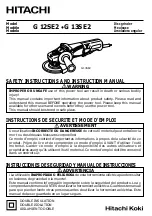
5
•
Keep visitors a safe distance from the work area. keep children away.
•
This product may contain one or more chemicals known to cause cancer
and birth defects or other reproductive harm. Wash hands after handling.
AIR SUPPLY
Please refer to the diagram below.
1.
Make sure that the air compressor being used for the air tool operation supplies
th
e
correct output (CFM).
2. Have the tool in the “off” position when connecting the tool
to
the
air supply.
3.
U
se
normal 90 ps
i
(or rang
in
g from 6.0 to 8.0 kg.) air pressure while running the tool.
High pressure and unclean air will shorten the tool’s
life
due
to
faster wear and also may
create a hazardous situation.
4.
Dra in water from air compres sor tank daily, as well as any condensation in the air lines.
Water in the air line may enter the tool and damage the tool mechanisms at operation.
5. Clean the air inlet filter cartridge weekly. The recommended hook-up procedure can be
viewed in the diagram below.
6.
Line pressure should be increased accordingly
to
make
up
for extra-long
air
hoses (usually
over
8 meters). The minimum hose diameter sh ould
be
1/4”
I.
D. and the
fittings should have the same inside dimensions. But usually a 3/8” l.D. air
hose
is
recommended
for
air
s
up
ply to get
the
best function of air tool operation.
7. Use proper hoses and fitting
s.
We do not suggest connecting quick change couplin
g
s
directly to the tool since they may ca use failure due to vibration. Instead, add
a
leader hose and connect coupling between air supp
ly
and hose whip.
8.
Check hoses for wear before individual use.
Ma
ke
certain
that
all
connections are
in
security.





























